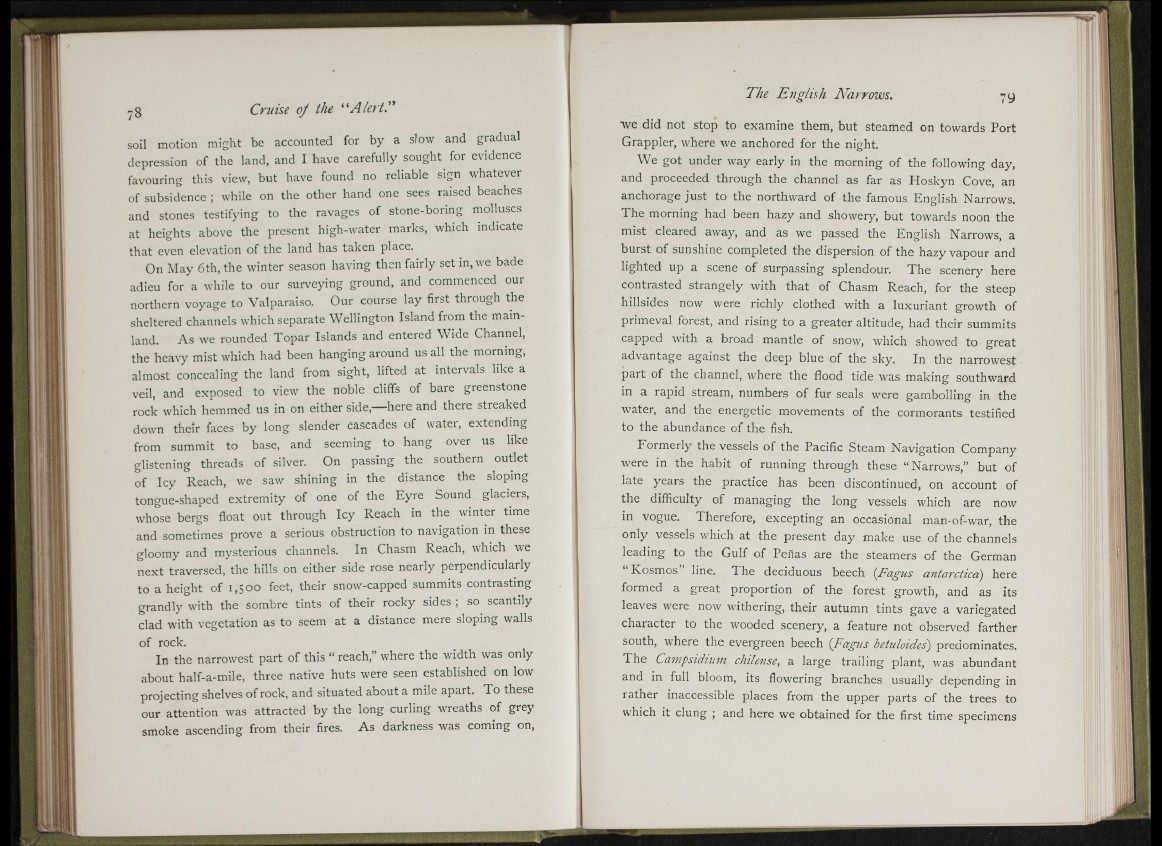
'' Ii
H i
soil motion might be accounted for by a slow and gradual
depression of the land, and I have carefully sought^ for evidence
favouring this view, but have found no reliable sign whatever
of subsidence ; while on the other hand one sees raised beaches
and stones testifying to the ravages of stone-boring molluscs
at heights above the present high-water marks, which indicate
that even elevation of the land has taken place.
On May 6th, the winter season having then fairly set m, we bade
adieu for a while to our surveying ground, and commenced our
northern voyage to Valparaiso. Our course lay first through the
sheltered channels which separate Wellington Island from the mainland.
As we rounded Topar Islands and entered Wide Channel,
the heavy mist which had been hanging around us all the morning,
almost concealing the land from sight, lifted at intervals like a
veil, and exposed to view the noble cliffs of bare greenstone
rock which hemmed us in on either side,— here and there streaked
down their faces by long slender cascades of water, extending
from summit to base, and seeming to hang over us like
glistening threads of silver. On passing the southern outlet
of Icy Reach, we saw shining in the distance the sloping
tongue-shaped extremity of one of the Eyre Sound glaciers,
whose bergs fioat out through Icy Reach in the winter time
and sometimes prove a serious obstruction to navigation in these
gloomy and mysterious channels. In Chasm Reach, which we
next traversed, the hills on either side rose nearly perpendicularly
to a height of 1,500 feet, their snow-capped summits contrasting
grandly with the sombre tints of their rocky sides ; so scantily
clad with vegetation as to seem at a distance mere sloping walls
of rock.
In the narrowest part of this “ reach,” where the width was only
about half-a-mile, three native huts were seen established on low
projecting shelves of rock, and situated about a mile apart. To these
our attention was attracted by the long curling wreaths of grey
smoke ascending from their fires. As darkness was coming on.
The English Narrows,
■we did not stop to examine them, but steamed on towards Port
Grappler, where we anchored for the night.
We got under way early in the morning of the following day,
and proceeded through the channel as far as Hoskyn Cove, an
anchorage just to the northward of the famous English Narrows.
The morning had been hazy and showery, but towards noon the
mist cleared away, and as we passed the English Narrows, a
burst of sunshine completed the dispersion of the hazy vapour and
lighted up a scene of surpassing splendour. The scenery here
contrasted strangely with that of Chasm Reach, for the steep
hillsides now were richly clothed with a luxuriant growth of
primeval forest, and rising to a greater altitude, had their summits
capped with a broad mantle of snow, which showed to great
advantage against the deep blue of the sky. In the narrowest
part of the channel, where the fiood tide was making southward
in a rapid stream, numbers of fur seals were gambolling in the
water, and the energetic movements of the cormorants testified
to the abundance of the fish.
Formerly the vessels of the Pacific Steam Navigation Company
were in the habit of running through these “ Narrows,” but of
late years the practice has been discontinued, on account of
the difficulty of managing the long vessels which are now
in vogue. Therefore, excepting an occasional man-of-war, the
only vessels which at the present day make use of the channels
leading to the Gulf of Peñas are the steamers of the German
Kosmos line. The deciduous beech {Fagus antárctico) here
formed a great proportion of the forest growth, and as its
leaves were now withering, their autumn tints gave a variegated
character to the wooded scenery, a feature not observed farther
south, where the evergreen beech {Fagus betuloides) predominates.
The Campsidium chilense, a large trailing plant, was abundant
and in full bloom, its fiowering branches usually depending in
rather inaccessible places from the upper parts of the trees to
which it clung ; and here we obtained for the first time specimens
iir ' '
-U!, ir'T"
m
i i i l . 11. H U